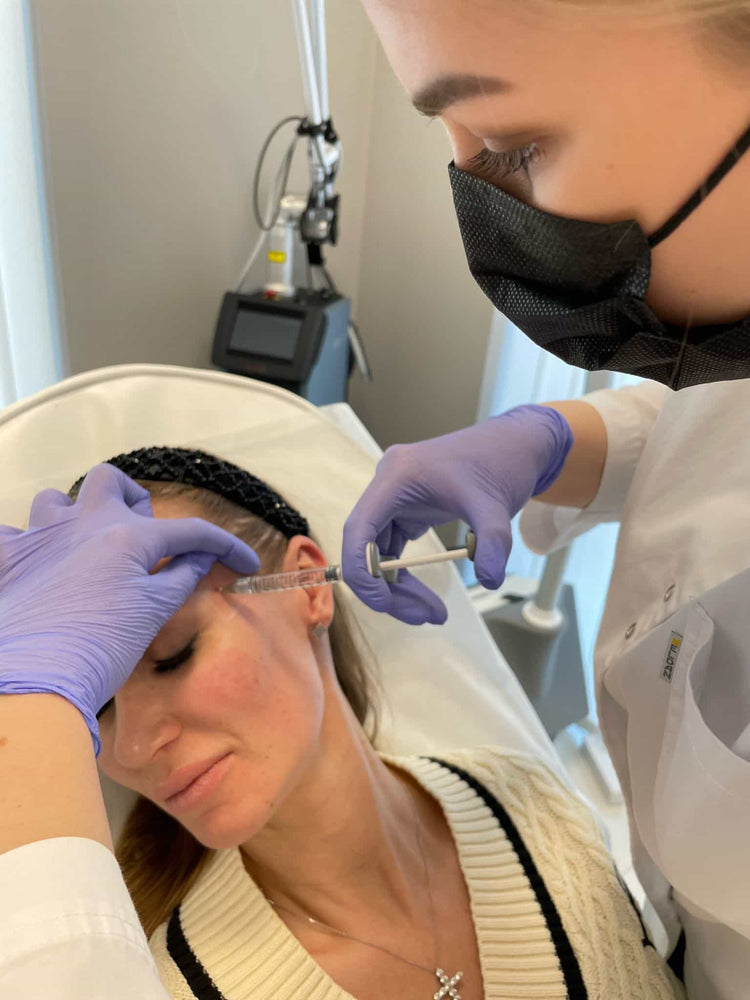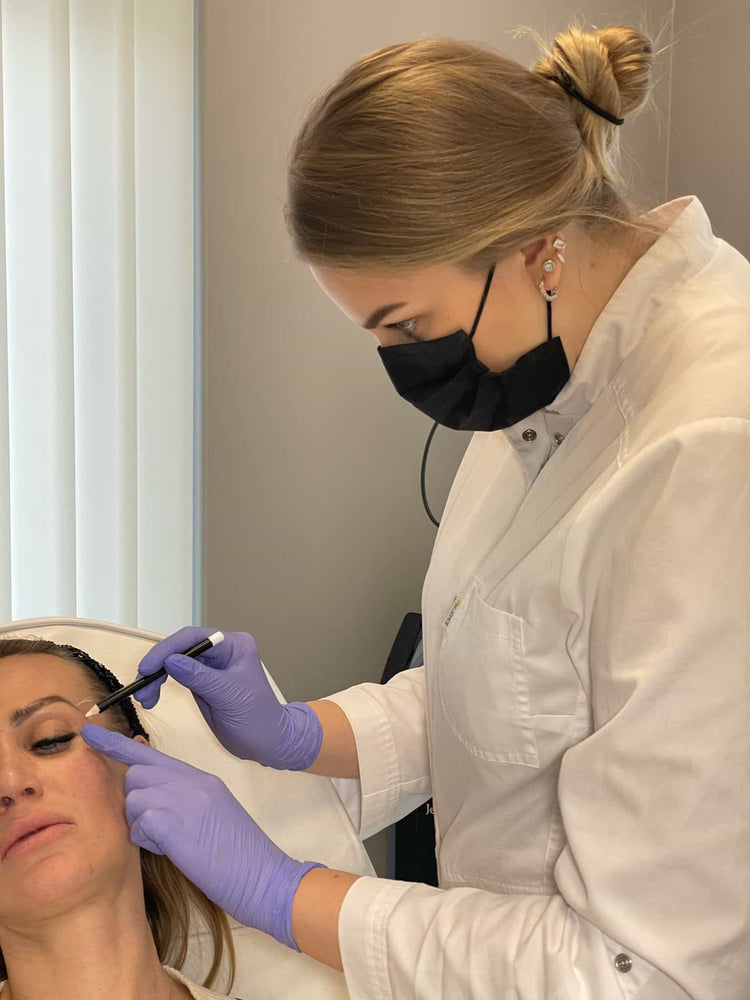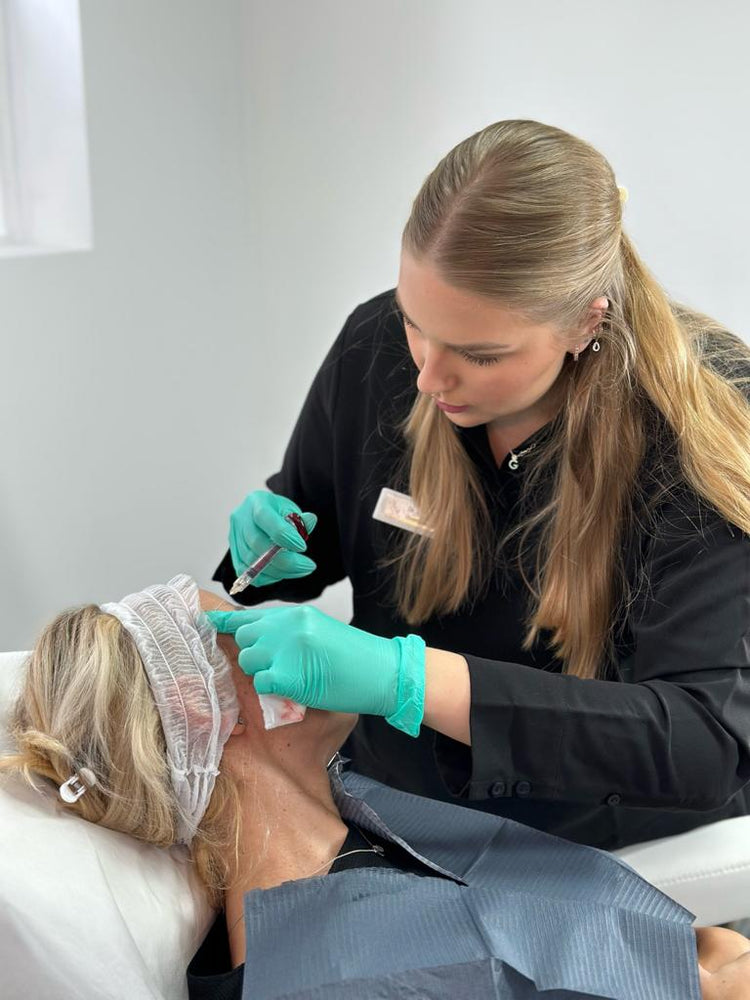What Are Temple Fillers?
Temple fillers are a popular non-surgical treatment designed to restore volume and definition to the temples, addressing sunken or hollowed appearance. This procedure involves injecting a soft tissue filler into the temple area, instantly plumping up the skin and creating a smoother, more youthful contour.
Dermal Fillers for Temples
Temple fillers are a non-surgical cosmetic procedure that addresses thinning or hollowness in the temples, often resulting from age, genetics, or weight loss. These treatments utilize soft tissue fillers, typically hyaluronic acid-based gels, which are injected into the temple area to restore lost volume and create a more contoured appearance.
The results of temple fillers are generally immediate and can last for several months to years depending on the type of filler used. Temple fillers can help enhance facial symmetry, rejuvenate the overall look of the face, and create a more youthful and defined profile.
In Kingston Upon Thames, a number of qualified practitioners offer temple filler treatments using safe and effective techniques. Before considering any cosmetic procedure, it’s crucial to consult with a licensed professional to discuss your goals, assess your suitability for treatment, and understand the potential risks and benefits.
Types of Fillers Used for Temples
There are various types of fillers used for temples, each with its own properties and longevity.
Hyaluronic acid (HA) fillers are among the most popular choices. They attract and retain moisture, providing a natural-looking plumpness that can last anywhere from 6 to 18 months. HA fillers are known for their biocompatibility and reversibility, meaning they can be dissolved if needed.
Calcium hydroxylapatite (CaHA) is another type of filler that provides volume and stimulates collagen production, leading to longer-lasting results compared to HA fillers. CaHA fillers typically last around 12 to 18 months.
Polylactic acid (PLA) fillers are synthetic polymers that gradually break down over time, stimulating the body’s own collagen production. This process leads to a more permanent volumization effect, with results lasting up to two years or more.
Benefits of Temple Fillers
Temple fillers offer a non-invasive approach to addressing hollow temples, restoring volume and contour for a smoother, more youthful appearance.
Enhanced Facial Symmetry
Temple fillers are a popular choice for individuals seeking to enhance facial symmetry and smooth the appearance of sunken or hollow temples.

- Improved Facial Harmony:
- Enhanced Contour and Definition:
- Youthful Resurfacing
- Non-Surgical Approach
Reduced Appearance of Hollowing
Temple fillers are a popular non-surgical treatment designed to restore volume and definition to the temples, addressing sunken or hollowed appearance. This procedure involves injecting a soft tissue filler into the temple area, instantly plumping up the skin and creating a smoother, more youthful contour.
- Improved Facial Harmony
- Enhanced Contour and Definition
- Youthful Resurfacing
- Non-Surgical Approach
Boosted Confidence
Temple fillers are a popular non-surgical treatment designed to restore volume and definition to the temples, addressing sunken or hollowed appearance. This procedure involves injecting a soft tissue filler into the temple area, instantly plumping up the skin and creating a smoother, more youthful contour. The benefits of temple fillers extend beyond just aesthetics; they can significantly boost confidence by enhancing overall facial harmony and restoring a more balanced look.

- Improved Facial Harmony
- Enhanced Contour and Definition
- Youthful Resurfacing
- Non-Surgical Approach
Temple fillers can help individuals feel more confident in their appearance by addressing concerns about sunken or hollow temples. The results of temple fillers are generally immediate and can last for several months to years depending on the type of filler used.
Procedure Details
Procedure details outline the specific steps involved in administering temple fillers. This information encompasses the type of fillers used, the injection technique, expected downtime, and post-treatment care instructions. Understanding these details is crucial for patients considering this treatment as it allows them to make informed decisions about their aesthetic goals and potential outcomes.
Consultation Process
Consultation with a qualified practitioner is the first step in the process of receiving temple fillers. During this consultation, a thorough evaluation of your facial structure, skin condition, and desired outcome will be conducted. The practitioner will discuss various filler options, explaining their properties, longevity, and suitability for your individual needs.
The actual procedure involves injecting the chosen filler into specific points within the temple area. This is typically done using a fine needle, and a topical anesthetic may be applied to minimize any discomfort. The entire process usually takes around 30 minutes to an hour, depending on the extent of treatment required.
Following the procedure, there may be some mild swelling, bruising, or redness at the injection sites. These side effects are typically temporary and subside within a few days. The practitioner will provide post-treatment instructions to ensure proper healing and minimize any potential complications.
Injection Technique
Temple fillers are administered through injections of hyaluronic acid gel or similar substances into specific points along the temple region. The technique involves using a fine needle to carefully deposit the filler beneath the skin, strategically targeting areas that have lost volume and creating a smoother, more contoured appearance.
The practitioner will determine the precise injection points based on your individual anatomy and desired outcome. They may use various techniques, such as linear threading or fanning, to ensure even distribution of the filler and achieve optimal results.
Post-treatment care involves gentle cleansing of the area, avoiding direct pressure or rubbing, and applying cold compresses to minimize swelling. The practitioner will provide detailed instructions on how to care for the treated area and what activities to avoid during the healing process.
Expected Downtime
Procedure details involve injecting a soft tissue filler into specific points along the temple region. A topical anesthetic may be applied to minimize any discomfort. The entire process usually takes around 30 minutes to an hour depending on the extent of treatment required.
Expected downtime varies depending on individual responses and the type of filler used. Most individuals experience minimal swelling, bruising, or redness that subsides within a few days.
Patients can typically return to normal activities the next day, although strenuous activity should be avoided for a week or two.
Recovery and Results
Temple fillers offer a non-invasive solution for addressing sunken or hollow temples, instantly restoring volume and creating a smoother, more youthful appearance. This popular treatment involves injecting soft tissue fillers into specific points along the temple region, strategically plumping up the skin and enhancing facial contours.
Post-Treatment Instructions
Temple fillers are a popular non-surgical treatment designed to restore volume and definition to the temples, addressing sunken or hollowed appearance. This procedure involves injecting a soft tissue filler into the temple area, instantly plumping up the skin and creating a smoother, more youthful contour.
- Improved Facial Harmony
- Enhanced Contour and Definition
- Youthful Resurfacing
- Non-Surgical Approach
Following the procedure, there may be some mild swelling, bruising, or redness at the injection sites. These side effects are typically temporary and subside within a few days. The practitioner will provide post-treatment instructions to ensure proper healing and minimize any potential complications.
- Avoid touching or rubbing the treated area.
- Apply cold compresses for the first 24-48 hours to reduce swelling.
- Take over-the-counter pain medication if needed to manage any discomfort.
- Continue with your regular skincare routine, avoiding harsh products or exfoliants.
It is important to attend all follow-up appointments scheduled by your practitioner. These appointments allow them to assess your healing progress, address any concerns, and make any necessary adjustments to the treatment if required.
Duration of Results
Temple fillers offer a non-invasive solution for addressing sunken or hollow temples, instantly restoring volume and creating a smoother, more youthful appearance. This popular treatment involves injecting soft tissue fillers into specific points along the temple region, strategically plumping up the skin and enhancing facial contours.
- Improved Facial Harmony
- Enhanced Contour and Definition
- Youthful Resurfacing
- Non-Surgical Approach
The duration of results from temple fillers varies depending on the type of filler used.
- Hyaluronic acid (HA) fillers typically last anywhere from 6 to 18 months.
- Calcium hydroxylapatite (CaHA) fillers can provide results for around 12 to 18 months.
- Polylactic acid (PLA) fillers, which stimulate collagen production, can last up to two years or longer.
Recovery from temple filler treatment is generally quick and minimal. Most individuals experience only mild swelling, bruising, or redness at the injection sites, which typically subsides within a few days.
Patients can usually resume their normal activities the next day. However, it’s recommended to avoid strenuous activity or excessive sun exposure for a week or two following the procedure.
Potential Side Effects
Temple fillers offer a minimally invasive approach to address concerns about hollowed temples. They are designed to instantly restore volume and create a smoother, more youthful contour.
The recovery period for temple fillers is typically quick with minimal downtime. Most individuals experience only mild swelling, redness, or bruising at the injection sites, which usually subsides within a few days. You can generally return to your normal activities the next day, but it’s best to avoid strenuous activity and excessive sun exposure for about two weeks.
Like any medical procedure, temple fillers do come with potential side effects, although they are generally mild and temporary. These can include:

- Swelling
- Redness
- Bruising
- Tenderness
- Asymmetry
- Lumps or bumps
It’s important to discuss any potential risks or concerns with a qualified practitioner before undergoing temple filler treatment.
Choosing a Qualified Practitioner
Choosing the right practitioner is crucial for ensuring a safe and successful experience when considering cosmetic treatments like temple fillers. Look for a licensed professional who has experience administering fillers specifically in the temple area.
Experience and Expertise
Choosing a qualified practitioner is essential for achieving optimal results and minimizing potential risks associated with temple filler treatments.
- Experience: Seek out practitioners with extensive experience performing temple fillers. Inquire about their number of successful procedures and their familiarity with various filler types and injection techniques.
- Expertise: Look for practitioners who specialize in facial aesthetics and have a deep understanding of facial anatomy. Their expertise will ensure precise filler placement and natural-looking results.
- Qualifications and Licensing: Verify that the practitioner is licensed and certified by relevant medical or aesthetic boards in your region. This ensures they meet established standards of practice and patient safety.
- Credentials and Training: Inquire about the practitioner’s training and certifications related to facial aesthetics and filler injections. Look for evidence of continuing education and participation in professional development courses.
Patient Reviews and Testimonials
When seeking temple fillers, patient reviews and testimonials can provide valuable insights into a practitioner’s expertise and the quality of their work. Look for consistent positive feedback regarding the practitioner’s skill, communication style, and ability to achieve natural-looking results.
Online platforms such as Google Reviews, RealSelf, and social media pages can offer a wealth of patient experiences. Pay attention to detailed reviews that describe the practitioner’s approach, the treatment process, and the overall outcome.
It’s also helpful to seek recommendations from friends or acquaintances who have undergone temple filler treatments. Their personal experiences can offer valuable firsthand insights.
Clinic Reputation
When choosing a practitioner for temple fillers in Kingston Upon Thames, it’s important to prioritize experience and expertise.
Look for practitioners who specialize in facial aesthetics and have extensive experience administering fillers, particularly in the temple area. A thorough consultation is essential. During this appointment, discuss your desired outcome, medical history, and any concerns you may have. A qualified practitioner will assess your suitability for treatment, explain the procedure in detail, and address any questions you have.
Clinic reputation also plays a vital role. Research potential clinics online, read patient reviews, and consider factors like hygiene standards, patient comfort, and overall professionalism. A reputable clinic will prioritize patient safety and satisfaction.
Discover how Temple Filler can restore volume with Dr. Laura Geige at It’s Me & You Clinic
